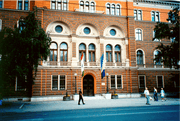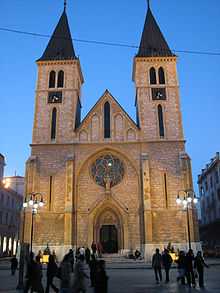Josip Vancaš
| Josip Vancaš | |
|---|---|
 Josip Vancaš, 1900. | |
| Born |
22 March 1859 Sopron, Kingdom of Hungary |
| Died |
15 December 1932 (aged 73) |
| Buildings |
Sarajevo Cathedral Presidency Building |
Josip Vancaš (22 March 1859 – 15 December 1932) was a Hungarian-born Croatian architect who spent most of his life in Sarajevo, Bosnia and Herzegovina where he designed over two hundred buildings. He also designed important buildings in present-day Croatia and Slovenia.
After completing secondary school in Zagreb, Vancaš studied architecture in Vienna under supervision of his mentor Friedrich Schmidt, expert in medieval architecture. He studied at the Technical University in Vienna from 1876 to 1881 and worked in the atelier of F.Fellner and H.Helmer. He adopted the implementation of eclecticism-historical styles from his later mentor Friedrich Schmidt who recommended him for the work on Sarajevo Cathedral. At the invitation of the Bosnian government he comes to Sarajevo in 1884 and remains there for thirty-seven years. He eventually became a leading figure in Sarajevo architecture, a member of the first Bosnian Parliament (1910), and deputy mayor of Sarajevo.[1]
During his long career Vancaš remained devote admirer of Viennese architectural trends and often included then in his Bosnia and Herzegovina projects. However he did not limit himself to merely imitating role-models and tried to adapt Viennese models to Bosnian conditions.
Historicism and eclecticism dominate in his works but the elements of Vienna Secession occur later as well. In his projects he goes from pseudo-romantic to pseudo-oriental influences. He studied the Bosnian local architecture and attempted, by applying its characteristic elements to implement “Bosnian style”.
During his time in Bosnia (1883–1921) he constructed 102 residential houses, 70 churches, 12 schools, 10 palaces, 10 banks, 10 government municipal buildings, 6 hotels and taverns, and remodeled a series of buildings. He also produced drafts for church altars as well as drawings for the residential and ecclesiastical interiors. In 1911, as a representative in Bosnia-Herzegovina Parliament, he submitted a resolution on the protection of cultural monuments in B&H.[2]

On 29 June 1914, he was one of the speakers seen talking to a crowd that later vandalized and looted Serb-owned property in Sarajevo during the unrest after Gavrilo Princip's assassination of Archduke Franz Ferdinand of Austria.
He has also written several studies on the Bosnian folk and urban architecture. From 1921 until his death in 1932 he lived in Zagreb.
His most significant works include Neo-Gothic Sarajevo Cathedral (1884–89), neo-Renaissance palace of what is today a Presidency Building, the Central Post Office in Sarajevo, pseudo-folklore pavilion of Bosnia and Herzegovina during the Millennial Exhibition in Budapest (1896), the palace of the Zagreb's First Croatian savings bank (1898–1900), the Normann palace in Osijek, and the Hotel Union and the City savings Bank and Savings bank in Ljubljana. He died in Zagreb December 15, 1932 at the age of 73.[3][4][5]
Buildings
| Buildings designed by Josip Vancaš | ||||||||||
|---|---|---|---|---|---|---|---|---|---|---|
| ||||||||||
See also
References
- ↑ Donia, Robert J. (2006). Sarajevo: a biography. University of Michigan Press. pp. 69–71, 350. ISBN 0-472-11557-X. Retrieved February 16, 2012.
- ↑ VisitSarajevo Publications: Josip Vancaš [cited February 16, 2012]
- ↑ Sarajevo City Info: Cathedral [cited February 16, 2012]
- ↑ Tourism: Grand hotel Union [cited February 16, 2012]
- ↑ Tourism: Municipal Savings Bank [cited February 16, 2012]
External links
| Wikimedia Commons has media related to Josip Vancaš. |




